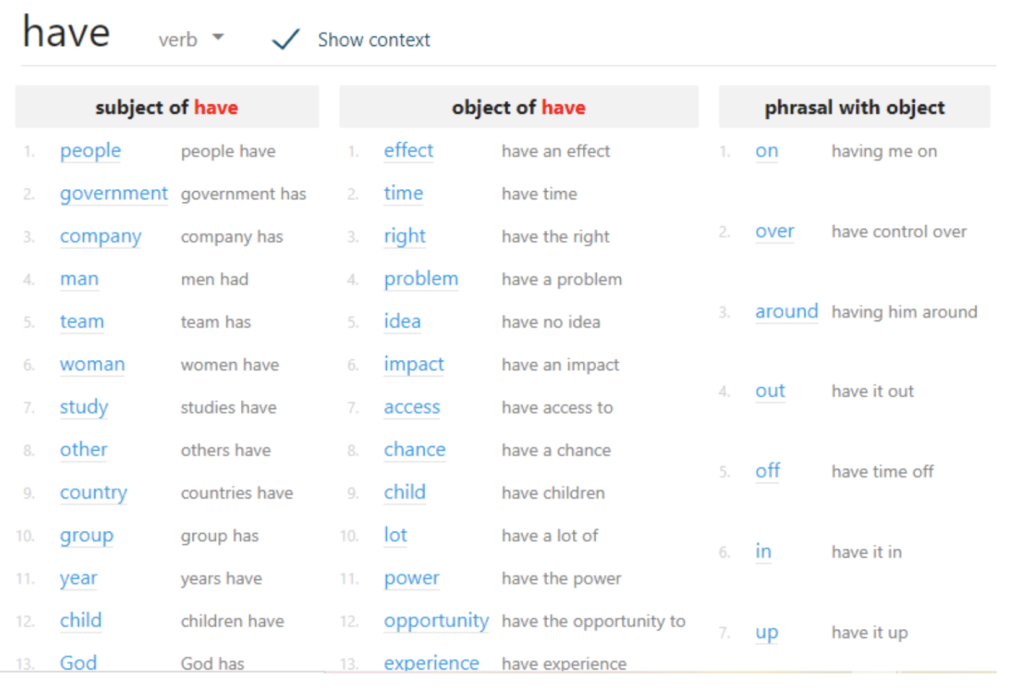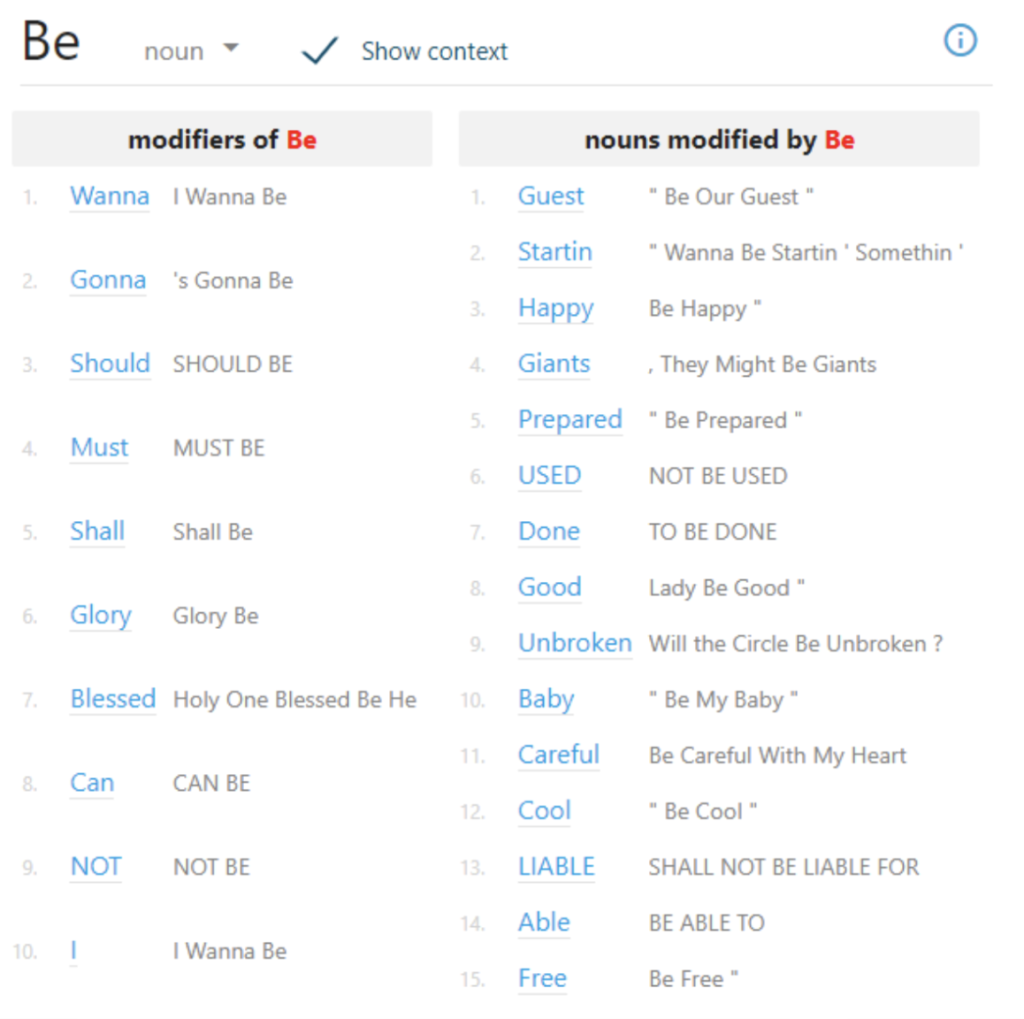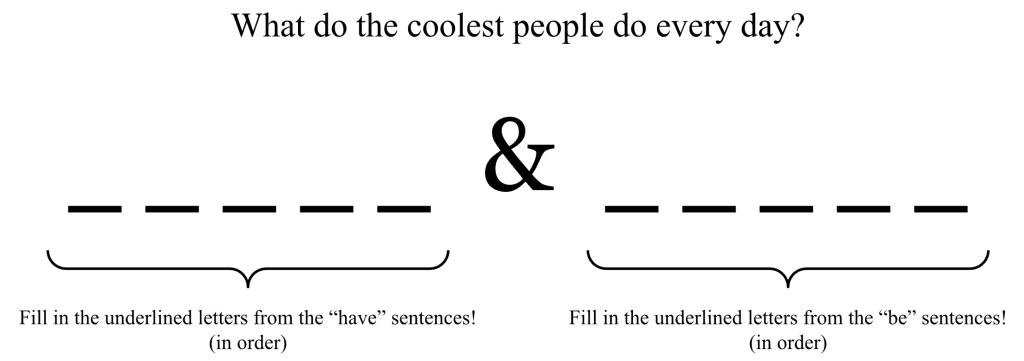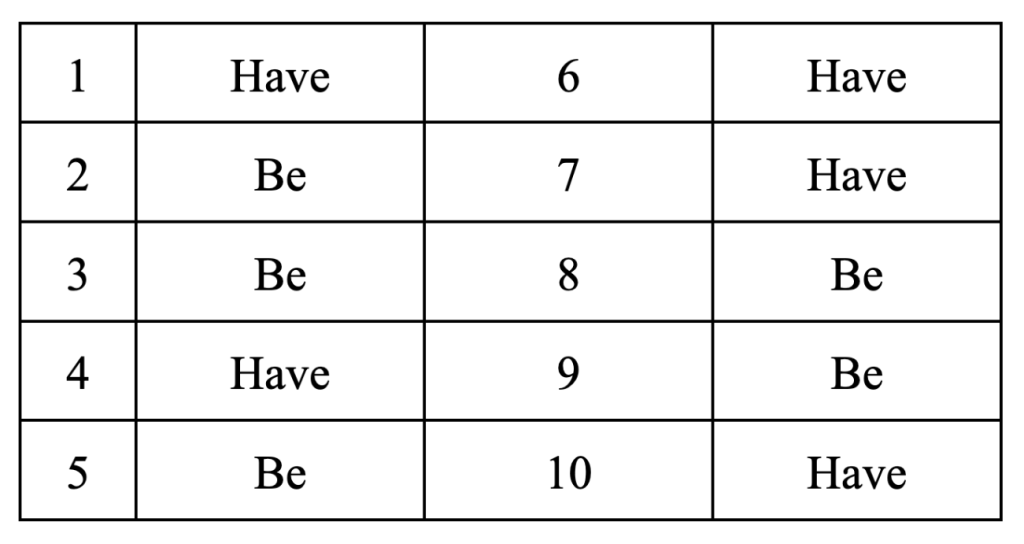10. Understanding the difference between “have” and “be”
Gabriela Mendes Brito; Vitória Neves; and Catie DeRienzo
Gabriela Mendes Brito
Undergraduate student at Federal University of Rio Grande do Sul
Vitória Neves
Undergraduate student at Federal University of Rio Grande do Sul
Catie DeRienzo
Undergraduate student at Montclair State University
Goals: To help students differentiate the meaning and usages of “have” and “be”.
Audience: Beginner English learners, ranging from middle school to adult-level classes
Duration: 35-45 minutes
INTRODUCTION
Learners of English struggle to understand the difference between “have” and “be” as these verbs might be used differently in their first language. In Portuguese, for example, speakers say I have 19 years, rather than I am 19 years old. As a consequence of L1 influence, English learners might use these two verbs as synonyms when in reality there are particular rules and contexts in which each of these verbs is used. The goal of this task is to help new English learners understand how and when these two words are used. An exercise will be provided at the end of the task to allow students to practice the newly-learned material.
STEP 1: CORPUS ANALYSIS
In the first phase of the class, the teacher will use the Word Sketch feature in SKELL to look at the concordance lines where these words appear. The results of each search shows that “have” and “be” are used in different contexts and that different words collocate with them. You can see the collocates by different parts-of-speech with the Word Sketch feature (see Figures).

Figure 1 – Skell search results for “have”

Figure 2 – Skell search results for “be”
During the lesson, the teacher should present these results to the class and discuss the differences between the two words we can see in the Word Sketch output. The goal is for students to learn and understand the difference between these verbs. While their definitions in English may be similar, their differences will become much clearer to students through discussion of their contexts and use as presented by the examples in SKELL.
STEP 2: PRACTICE ACTIVITIES
In the following activity, students will fill in the gaps of the sentences with either “have” or “be”. These sentences are derived from the search results of each verb on Skell, so these will reflect the observations the teacher and student make when discussing their differences in the previous phase of the lesson. With the help of these full sentences and individual practice through this activity, students should be able apply their knowledge from the lecture and understand the context to make the correct choice for each sentence.
Activity #1:
Fill in the gaps – The verbs can appear in the infinite , gerund form ,simple present or simple past
- This corrupt judge ………… apparently having temporal delusions.
- Some are general whereas others …………. Specific.
- So far module 2 ………. been realized.
- Californian politics ………….become highly “partisan”
- Mobile wallet ………….. here where is America’s cheapest real estate
- The chest …………. deep without being broad.
- The civilian death toll …………. reached four figures.
- This whole theory has always …………. counter intuitive
- The church ……….. experienced tremendous growth despite intense persecution.
Activity #2:
Fill in the blanks with the right verb: “have” or “be.” Then, use the underlined letters at the beginning of each “have” sentence and “be” sentence to reveal the answer to the question at the bottom of the page!

- She looks young enough to be 20, and I ________ a feeling she will always have that young look.
- Lee apparently had a reason to ________ nervous.
- Each client need not ________ ashamed or embarrassed of consulting their problem to a health practitioner.
- They like to come together to ________ fun and talk about Texas.
- At my urban high school, it was not uncommon for students to ________ absent 40+ days per school year.
- The University’s Library System is huge, but we ________ faith that you’ll be able to navigate it just fine.
- Don’t come near me; I ________ a cold.
- Rajon Rondo says he wants to _______ known as the best point guard in the league.
- Needless to say, it would only _______ a matter of time until he resigned.
- “You are pregnant. You are going to _________ a baby.”
Activity #3:
In this third activity, students will be prompted to compare the two verbs on Skell and note the difference between the words that often appear with them. For this exercise, each student will need access to a computer to use Skell. Students will search for each word on the search engine and take notes of the words that come before and after the verb. With this information, they should find sentences in which the two verbs share the same word. The goal of this exercise is to further help students recognize the difference between verbs, as the results will show very few contexts in which the verbs have similar surrounding words.
Instruction to students: Search for “have” and “be” on Skell and take note of the most frequently occurring words that come before and after the verb. Try to find sentences where the two verbs share at least one of the same surrounding words.
Answers
Exercise 1: A- IS B- ARE C- HAS D- HAS E- IS F- IS G- HAS H- HAS I- HAD
Exercise 2: What do the coolest people do every day? STUDY & LEARN

DeRienzo, C., Mendes Brito, G., & Neves, V. (2023). Understanding the difference between “have” and “be”. In L. Goulart & I. Veloso (Eds). Corpora in English Language Teaching: Classroom Activities for Teachers New to Corpus Linguistics. Open Educational Resource. Montclair State University.
